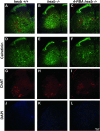4-Phenylbutyric acid mitigates ER stress-induced neurodegeneration in the spinal cords of a GM2 gangliosidosis mouse model
- PMID: 39530163
- PMCID: PMC11756275
- DOI: 10.1093/hmg/ddae153
4-Phenylbutyric acid mitigates ER stress-induced neurodegeneration in the spinal cords of a GM2 gangliosidosis mouse model
Abstract
Sandhoff disease (SD), a fatal and rare lysosomal storage disorder (LSD), is caused by a deficiency of the enzyme β-hexosaminidase B and leads to severe accumulation of GM2 gangliosides in lysosomes, primarily within the central nervous system (CNS). This accumulation results in severe neurological impairment, lower motor neuron disease, and death. Currently, there are no effective therapies available for SD. Here, we explored the role of endoplasmic reticulum (ER) stress in the spinal cord during disease progression in an established mouse model of SD and revealed the beneficial outcome of off-label treatment with the FDA-approved drug, 4-phenylbutyric acid (4-PBA). We analyzed the expression and localization of ER stress and cellular apoptosis markers, which revealed significant upregulation of these factors within motor neurons. Additionally, we observed a > 50% reduction in neuronal numbers throughout all spinal cord regions. Our studies also tested the impact of the chemical chaperone 4-PBA on ER stress in mice, and following administration, we observed significant improvements in motor neuromuscular function and life span throughout disease progression. 4-PBA treatment significantly reduced apoptosis in spinal cord neurons and increased the number of choline acetyltransferase (ChAT)-positive neurons, with little effect on astrogliosis or sensory interneurons. Overall, this study provides strong evidence for the role of chronic ER stress in the pathophysiology of SD and highlights 4-PBA as a promising therapeutic treatment for SD and potentially other related LSDs.
Keywords: ER stress; Tay Sachs; lysosomal storage disease; lysosome; spinal cord.
© The Author(s) 2024. Published by Oxford University Press.
Conflict of interest statement
The authors declare the following competing interests: FEW, CAN, RCA, and SAI have filed an institution-owned patent, entitled: ‘Methods for the treatment of lysosomal storage diseases’ (US patent number 12042476 B2) that relates to the use of 4-PBA for the treatment of Sandhoff disease.
Figures










References
-
- Khoueiry M, Malek E, Salameh JS. Adult onset Sandhoff disease: a rare mimicker of amyotrophic lateral sclerosis. Amyotroph Lateral Scler Frontotemporal Degener 2020;21:144–146. - PubMed
-
- Klopman Z, Natteru P, Shukla S. et al. Spinal muscular atrophy mimicking adult-onset GM2 Gangliosidosis AB variant: a case report (2963). Neurology 2021;96:2963.
MeSH terms
Substances
Grants and funding
LinkOut - more resources
Full Text Sources

